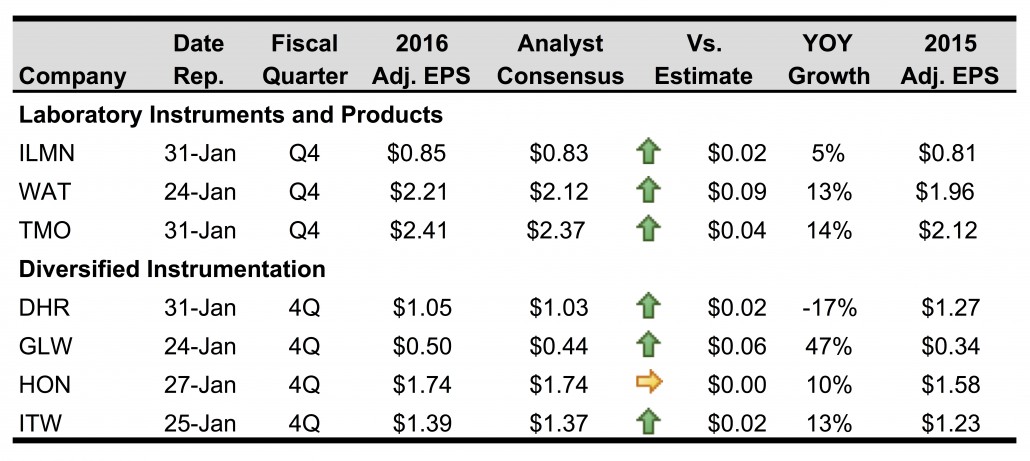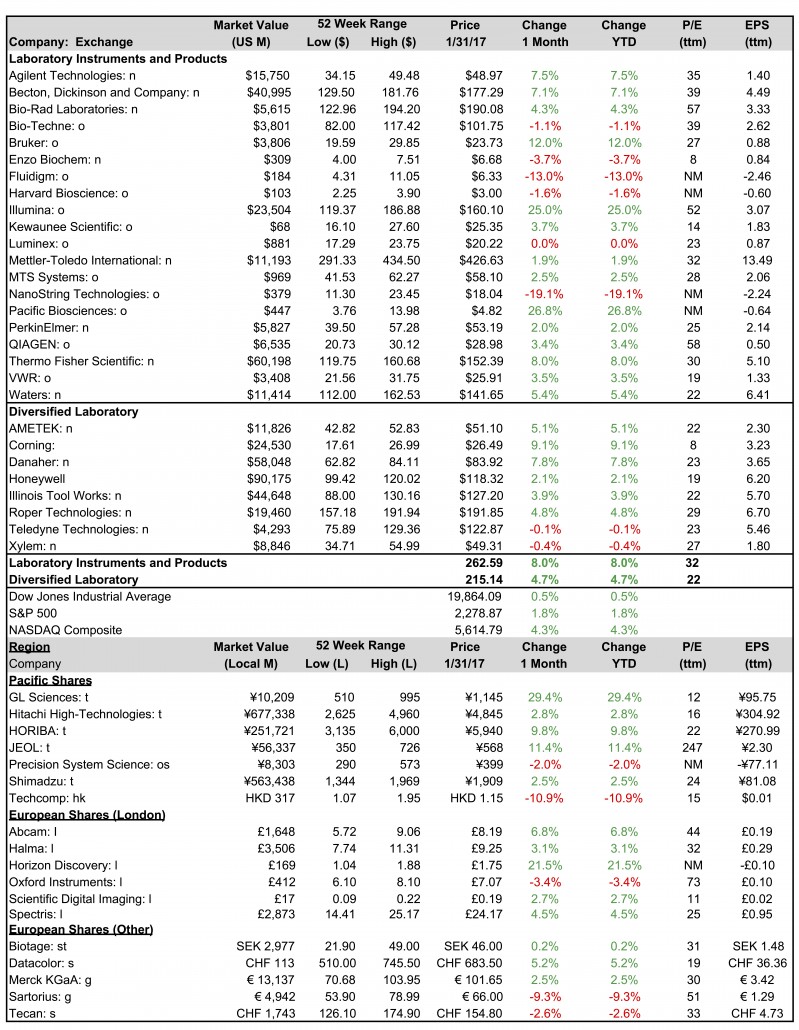Positive Start for IBO Indexes
US equity markets got off to a confident start in 2017, as the Dow Jones Industrial Average broke the 20,000 mark for the first time. Investor exuberance was spurred by the Trump administration’s promise to stimulate funding, reduce taxes and roll back regulations. In addition, economic data signaled progress including strong consumer spending and improved capital goods orders, especially for mining and energy equipment.
Unfortunately, the Dow quickly retreated from the historic mark in the final trading days of the month due to questionable US policy implementations and lackluster economic data. President Trump’s protectionist trade and immigration policies incited global dissension and geopolitical concerns. Furthermore, fourth quarter 2016 US GDP growth, despite a strong inventory build, came in below expectations at 1.9%. Nevertheless, equity markets finished higher in January as the Dow, S&P 500 and NASDAQ advanced 0.5%, 1.8% and 4.3%, respectively.
Perhaps the only certainties in 2017 will be heightened equity and currency volatility. While early indications suggest that President Trump’s policies will be met with congressional opposition or reprisal in foreign regions, especially if they impose trade restrictions, the net influence of his policies on the US economy, if enacted, remain uncertain. Furthermore, inflationary pressure will put a spotlight on US monetary policy in 2017, which has largely supported equity prices for the last eight years. Should the Fed raise interest rates and wind down bond purchases, markets will need to focus on valuations, which are trending towards the high side based on trailing 12-month EPS.
Laboratory Instruments and Products
The Index advanced 8.0% to 262.59 in January as a majority of companies traded higher due to strong earnings results or positive outlooks. Following prominent declines in 2016, NGS firms Illumina and Pacific Biosciences gained 25.0% and 26.8% for the month, respectively, leading the Index.
Pacific Biosciences, which ended 2016 at a multi-year low, experienced increased buying volume and was further boosted by new Sequel system purchase agreements. The company reported orders for 15 Sequel systems by two Chinese firms.
Meanwhile, Illumina regained investor’s confidence following several positive announcements at the JPMorgan Healthcare Conference on January 9. The company preannounced fourth quarter 2016 sales growth of 5%, which was above its revised guidance of roughly flat growth. The company also introduced a new high-throughput NGS system and forecasted 2017 sales to grow 10%–12%. Shares jumped 16.6% the following day.
On January 31, Illumina officially reported earnings, which were slightly above expectations. The company projected 2017 adjusted EPS of $3.60–$3.70, including $0.60–$0.65 in the first quarter. CL King and Bank of American each upgraded Illumina from “Neutral” to “Buy” on January 6 and January 10, respectively. Bank of America also raised its price target for the company from $161 to $175 per share.
QIAGEN, which improved 3.4% for the month, also initiated its 2017 sales growth forecasts at the JPMorgan Healthcare Conference on January 9. The company maintained its full-year 2016 organic sales growth outlook of 4%–5% and projected 2017 organic sales to grow 5%–6%.
Similar to Illumina, both Thermo Fisher Scientific and Waters posted stronger-than-expected fourth quarter 2016 adjusted EPS due to continued strength in Asia and biopharmaceutical markets, as well as a recovery in European academic spending. The two companies also recorded full-year adjusted EPS growth of roughly 12%. On January 24, Waters forecasted first quarter and full-year 2017 adjusted EPS of $1.26– $1.36 and $6.85– $7.10 for growth of 4% and 5%, respectively. On January 31, Thermo Fisher projected 2017 adjusted EPS to grow 10%–12% to $9.06–$9.24.
Not all companies started the year on a strong note. NanoString Technologies recorded the sharpest decline for the month, falling 19.1%. Shares contracted 21.7% on January 10 as the company preannounced fourth quarter 2016 sales in the range of $24.2–$25.7 million, slightly below its previous guidance due to slower academic spending and a smaller-than-expected budget flush from biopharmaceutical customers.
Fluidigm failed to impress investors on January 9 despite improved preliminarily fourth quarter 2016 sales growth. Following weak financial results in the second and third quarters of 2016 due to growing competition and poor operational efficiency, Fluidigm preannounced fourth quarter 2016 sales of $24.7–$25.2 million for growth of 12%. However, full-year 2016 sales are expected to decline 9% to $104.1–$104.6 million, representing a 17% variance from its initial year outlook of $124–$128 million. Shares fell 13.0% for the month.
There were several other ratings changes this month. Becton, Dickinson was downgraded by JP Morgan Chase from “Overweight” to “Neutral” on January 3, and by Raymond James from “Strong Buy” to “Outperform” on January 5. Deutsche Bank downgraded VWR on January 18 from “Buy” to “Hold,” and set a price target of $26 per share.
Conversely, on January 4, Barclays PLC upgraded Agilent Technologies from “Equal Weight” to “Overweight,” and raised its price target from $48 to $51 per share.
Diversified Laboratory
The Index expanded 4.7% in January to 215.14 with most companies trading higher. Driven by stronger-than-expected financial results, Corning and Danaher recorded the strongest gains for the month, climbing 9.1% and 7.8%, respectively. On January 24, Corning reported that fourth quarter 2016 adjusted EPS grew 47% to $0.50 due to strength in the Specialty Materials segment. Full-year 2016 adjusted EPS grew 11%. The company projected positive momentum going into 2017.
On January 31, Danaher reported that comparable fourth quarter and full-year 2016 adjusted EPS advanced 16% and 21% to $1.05 and $3.08, respectively, due to continued margin expansion, strong biopharmaceutical sales and sturdy demand in China. The company also reaffirmed its 2017 adjusted EPS outlook of $3.85–$3.95, which it initiated at the JP Morgan Healthcare conference on January 9. First quarter adjusted EPS are expected to be $0.82–$0.85.
Illinois Tools Works also beat analysts’ fourth quarter 2016 consensus on January 25 but missed on revenue expectations. The company reaffirmed its 2017 adjusted EPS outlook of $6.00–$6.20 for growth of 9%. Shares improved 3.9% for the month.
Honeywell also stayed positive for the month, advancing 2.1% despite missing fourth quarter 2016 sales expectations on January 27. However, adjusted quarterly EPS were in line with consensus. The company projected 2017 adjusted EPS of $6.85–$7.10.
International
Asia Pacific equity indexes were mostly positive in January, led by Hong Kong’s Hang Seng and Singapore’s STI, which rose 6.2% and 5.8%, respectively. Japan’s Nikkei 225 slipped 0.4%. The Bank of Japan surprised the markets by increasing its bond purchases to lower yields.
Most Pacific Rim companies in the IBO Stock Table traded higher for the month, led by GL Sciences, which jumped 29.4%. On January 27, the company raised its fiscal 2017 sales growth outlook from 6% to 9% due to improved results for its analysis equipment and semiconductor businesses. The company also boosted its fiscal EPS estimate by 58% to ¥115.35 ($1.05) for growth of 53% due to significant cost reductions.
Hitachi High-Technologies, which climbed 2.8% for the month, reported stronger-than-projected earnings on January 27. Fiscal third quarter EPS ending December 31, 2016, grew 19% to ¥89.82 ($0.82). The company raised its fiscal year EPS guidance by 10% to ¥283.58 ($2.58) for growth of 8%.
Two Pacific Rim companies declined this month, Precision System Science and Techcomp, which fell 2.0% and 10.9%, respectively.
European equity markets were mixed in January. Sweden’s OMX and Germany’s DAX improved 1.9% and 0.5%, respectively, while the UK’s FTSE 100 and Italy’s MIB contracted 0.6% and 3.3%, respectively.
With the exception of Oxford Instruments, which slipped 3.4%, all other UK-based companies in the IBO Stock Table finished the month in positive territory. Horizon Discovery gained the most ground for the month, climbing 21.5%. The company provided a trading update on January 24, which fell in line with its previous expectations of more than 19% sales growth for 2016. The company also projected 2017 sales to grow in the 30% range to £30–£35 million ($33–$39 million) including currency tailwinds.
On January 10, Abcam reaffirmed its fiscal-half year outlook ending December 31, 2016, which included sales growth of 30%, or 10% excluding currency. Shares advanced 6.8% for the month.
Scientific Digital Imaging, which advanced 2.7% for the month, reported on January 24 that adjusted EBIT climbed 143% to £421,000 ($0.5 million) for the six months ending October 31, 2016, due to the acquisition of Sentek. Share improved 2.7% for the month.
Prices for other European companies in the IBO Stock Table were mixed in January. Datacolor improved 5.2%, while Sartorius recorded the largest decline for the month, falling 9.3%. On January 30, the company reported strong adjusted 2016 EPS growth on January 30, which jumped 23% to €1.93 ($2.14). However, the company projected slower currency-neutral sales growth of 8%–12% in 2017, compared to 20% in 2016. Capital expenditures are also expected to climb in 2017, which will slow net income growth.




